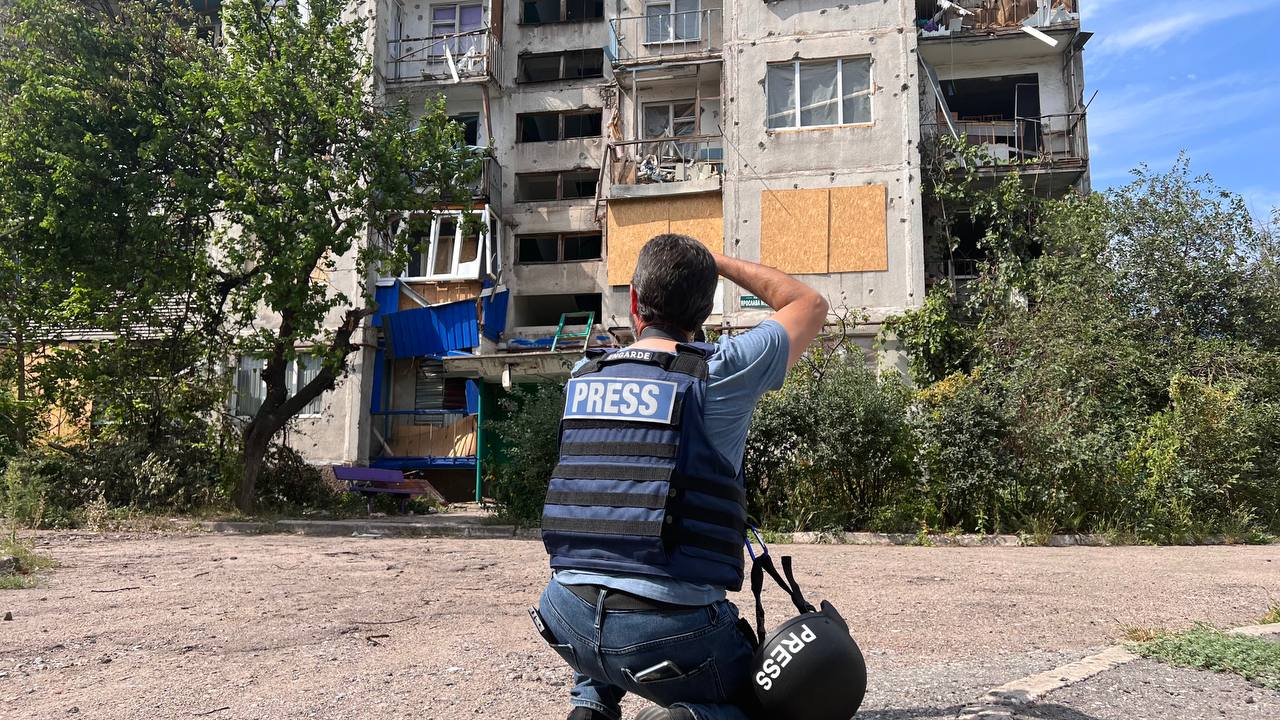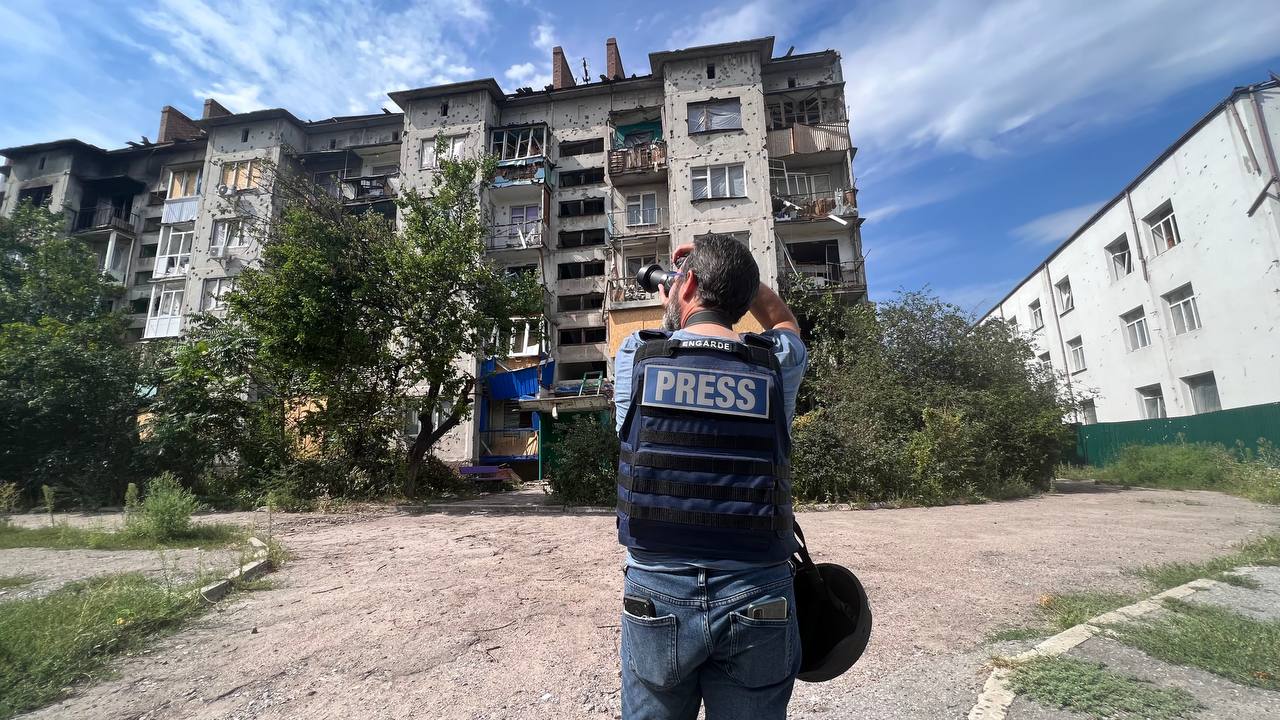Imagine you are in a war zone. Bullets are zooming left and right, screams and frantic energy surrounds you. All the while your only goal is to be a witness and to lend your eyes to the rest of the world. This is the reality many combat reporters face. In today’s world, journalists are among the most courageous professionals, venturing into the most dangerous places on earth to uncover truths. Truths that would otherwise remain hidden. They face wars, political upheavals, and humanitarian crises and aim to shine a light on the human toll of conflict. Armed with notebooks, cameras, and a determination to expose injustice, they risk their lives to ensure the global public remains informed.
Unfortunately, this vital mission comes with immense danger. In 2022 alone, UNESCO reported the deaths of 86 journalists worldwide. Many of whom were killed in conflict zones like Ukraine, Syria, and Afghanistan. The ever-present dangers of war are not just physical but psychological, leaving correspondents grappling with the emotional toll of witnessing death, destruction, and human suffering. In these environments, body armor is often regarded as the last line of defense and has become an essential part of a journalist’s survival kit. But while a bulletproof vest or helmet offers some protection, it does not prevent the wearer from suffering no harm, especially as modern warfare evolves and new threats emerge.
Body Armor: The Last Line of Defense
Through the stories of veteran correspondents like Matthijs le Loux, Alberto Hugo Rojas, Peter Ter Velde, Sakir Khader, and others, we can uncover the complex role of body armor in journalism. Specifically the physical and psychological burdens it imposes, and the determination of those who continue to report from some of the most unpredictable places on earth.
The stories of Bob Woodruff and Stuart Ramsay really exemplify the importance of body armor in conflict reporting. In 2006 Bob Woodruff escaped the hands of death because of the body armor he was equipped with. While reporting in Iraq, Woodruff and his cameraman Doug Vogt were severely injured by a roadside bomb. Woodruff suffered traumatic brain injuries and broken bones, but doctors credited his body armor for preventing potentially fatal wounds. Without the protection of his vests Woodruff would not have lived to tell his tales.
Similarly, in 2022, Sky News correspondent Stuart Ramsay had a life-threatening encounter while covering the war in Ukraine. Ramsay was traveling near Kyiv, when his team was ambushed by Russian operatives. When gunfire began he was unfortunately shot in the lower back. Though he sustained injuries, his ballistic vest absorbed the bullet, sparing him from a fatal outcome. In both these cases, the body armor was not infallible, but it played a pivotal role in preventing death or serious injury.
The Burden of Body Armor
For journalists like Ramsay and Woodruff, body armor is a necessary, and often lifesaving, piece of equipment. Another journalist who has had similar experiences is Matthijs le Loux, a foreign affairs reporter for NU.nl. He has encountered the same sense of reliance on body armor when working in the conflict zones of Israel and Ukraine. However, he also acknowledges its limitations.
“It’s heavy, physically and emotionally,”
he told Body Armor News. He explained to us the burden of wearing a vest that weighs 25 to 35 kilograms when combined with other important gear like cameras and helmets. Yet, going without it is simply not an option, given the risks faced in active combat zones.
While body armor provides a level of physical protection, it also carries a profound psychological burden. Although this is not inherent to the body armor, but rather a symptom of the greater fears of reporting in areas of conflict. Freelance war photographer Alberto Hugo Rojas, who has covered conflicts in Syria, Iraq, and Ukraine, spoke to us candidly about how wearing a ballistic vest heightened his sense of awareness in a way that was emotionally draining. “You never know when or where something will strike,” he explained. Every noise, every shadow, became a potential sign of danger, leaving him constantly on edge.

This hypervigilance can take a significant toll on a journalist’s mental health. Rojas describes how even the best preparation cannot guarantee safety in active war zones. “The unpredictability of attacks, whether from missiles, sniper fire, or stray bullets, makes it impossible to feel secure,” he said. The emotional exhaustion of being in a constant state of alertness weighs heavily on journalists, adding to the stress of their work.
Peter Ter Velde, a former war correspondent who now works as a security advisor for NOS, has similar experiences to both Le Loux and Rojas when discussing body armor. “The vest can protect you physically, but it can’t make decisions for you,” he said. His words highlight the need for journalists to be aware of their surroundings and to continuously assess the ever-changing risks of their environments. Because of the growing complexity of modern conflict zones, there has been a significant push for better training and preparedness for journalists working in dangerous environments. Ter Velde now works with organizations that provide workshops on risk assessment, equipment usage, and survival strategies. Workshops that were not available to him as a young journalist decades ago. These training sessions aim to equip journalists with the knowledge they need to stay safe while reporting in volatile areas.
Ter Velde emphasized the importance of understanding the limitations of one’s body armor. “Many journalists don’t even know the level of protection their vests offer,” he said. Some vests, for example, are designed to protect against small-arms fire but may not be sufficient against high-caliber rounds or shrapnel. Knowing the capabilities of the gear can mean the difference between life and death.
Evolving Risks: Journalists as Targets
While body armor has undoubtedly saved countless lives, it has also come to symbolize a growing and troubling reality: journalists are increasingly being targeted in conflict zones. In the past, wearing a vest labeled “PRESS” could provide journalists with a modicum of protection, signaling their role as non-combatants. But in today’s world, this marker often makes them more conspicuous and vulnerable to attack.
The killing of Palestinian-American journalist Shireen Abu Akleh in 2022 serves as a stark reminder of this shift. Abu Akleh was reporting in the West Bank, wearing a vest clearly marked with the word “PRESS,” when she was fatally shot in the head by Israeli forces. Despite the visible identification as a journalist, investigations suggest that she was deliberately targeted. Her death sparked widespread condemnation and calls for accountability, highlighting the increasingly hostile environment in which journalists operate.
Sakir Khader, a Palestinian filmmaker and photojournalist, echoed this grim reality. “War has changed, and body armor can no longer guarantee safety,” he told us, reflecting on his own experiences documenting violence in Palestine and Iraq. In some regions, wearing protective gear or sporting a press insignia once provided a measure of security. Now, however, it often makes journalists even more visible—and vulnerable.
Khader described how Israeli soldiers in certain areas may deliberately aim for unprotected areas such as the head or knees, attempting to disable journalists without necessarily killing them. The rise of drone warfare and the increasing use of high-caliber weapons and precision strikes further challenge the efficacy of traditional body armor. As Khader put it, “There’s no respect for the press anymore. You can be targeted anytime, anywhere.”
Freelancers: Navigating Logistical and Financial Hurdles
For freelance journalists, the challenges of working in conflict zones are compounded by logistical and financial hurdles. Unlike their counterparts working for major media organizations, freelancers often have to bear the cost of their own safety equipment. As Alberto Hugo Rojas explained, he owns a Level 4 ballistic vest from Engarde with neck and shoulder protection, but he cannot afford additional armor for his arms or groin. “It’s not ideal,” he admitted, “but going without isn’t an option.”
Organizations like Reporters Without Borders (RSF) and the Committee to Protect Journalists (CPJ) have stepped in to help by offering loaner vests and other assistance. However, as the demand for these resources often outstrips supply, freelancers are left to navigate the dangers of conflict zones without the comprehensive support enjoyed by journalists working for larger organizations.
One of the most difficult decisions that journalists face when working in conflict zones is whether or not to wear body armor at all. In some situations, the visible presence of a vest or helmet can provide protection by identifying the wearer as a non-combatant. In other scenarios, however, it can make the journalist a target.
Matthijs le Loux, who reported from eastern Ukraine, explained the tension between safety and visibility. “You have to weigh the benefits of protection against the risks of standing out,” he said. In some cases, blending in with civilians may offer better protection than donning a conspicuous vest that marks the journalist as an outsider. As Ter Velde advises in his training sessions, adaptability is key: journalists must evaluate the unique risks of each environment and make decisions accordingly.
The Call for Comprehensive Support
As conflicts become more complex and dangerous, the need for comprehensive support for journalists has never been greater. Organizations like RSF, CPJ, and the Rory Peck Trust are advocating for better access to protective equipment, training, and mental health resources to help ensure that journalists can continue their work safely and effectively.
But as the stories of the journalists in this article show, body armor is only one part of the equation. The broader issue is the need for systemic change to ensure the safety, well-being, and continued support of those who risk their lives to bring the world the truth.







